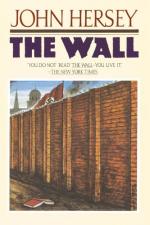|
This section contains 337 words (approx. 2 pages at 300 words per page) |

|
Nazi atrocities in Poland were vividly described in The Black Book of the Polish Jewry (1943). A section on the destruction of the Warsaw Ghetto was included. One of Hersey's primary sources was Emmanuel Ringelblum's chronicle, the most celebrated of Jewish communal archives documenting the Jews' experiences under German occupation. Oneg Shabbat gives an account of events from September 1939 to 1943 when Ringelblum was killed.
The work had been published in its original Yiddish, but in a bowdlerized version, in 1952. A complete revised edition appeared in 1963. The English translation, Notes from the Warsaw Ghetto (1958), is based on the 1952 edition. It is one of the works Hersey had on his wire recordings.
An earlier work whose subject matter parallels the experiences of the defenders of the Warsaw Ghetto is The Forty Days of Musa Dagh (1934) by the Austrian poetnovelist Franz Werfel. In World War I Turkey became an ally...
|
This section contains 337 words (approx. 2 pages at 300 words per page) |

|




